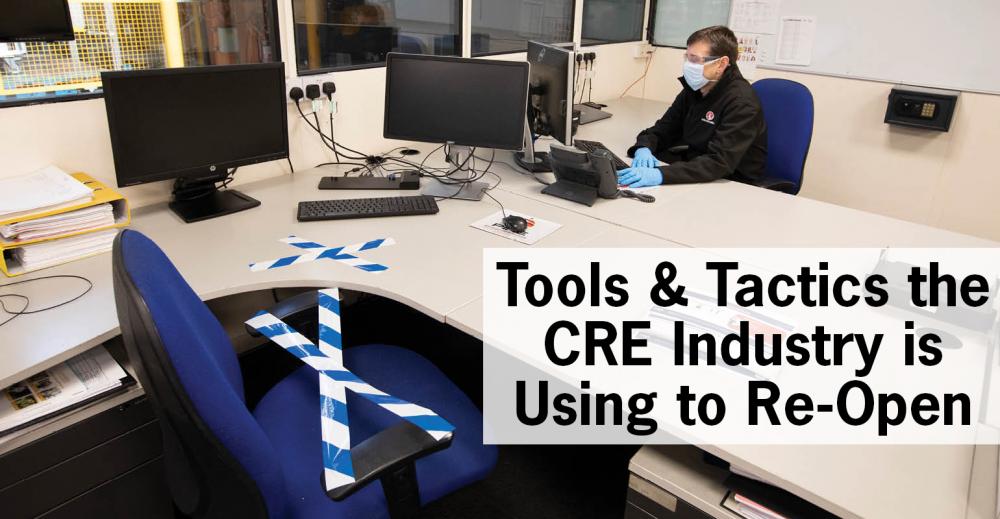1 17
1 17
The popularity of open offices and reductions in overall square footage per person in office environments is going to mean a permanent rise in remote working. For many offices it simply will not be possible to return to previous levels of office occupancy while adhering to safe social distancing practices.
Not all office workers will remain off site, although many companies have announced policies that any worker who doesn't feel comfortable returning to an office environment will not be compelled to do so. The net result will be a shift in balance, with more workers staying remote and less densely populated offices for workers that return.
Until there's a vaccine or a reliable cure, stopping the spread of COVID-19 will require masks to become a part of everyday life. Expect masks to be required to be worn at all times in many buildings for the foreseeable future.
Unfortunately, this simple public health measure has become a politicized issue in the U.S., with many now refusing to wear masks. And while the norm for many businesses reopening is to require masks, a small subset of businesses is going the other route: refusing service to patrons wearing masks.
The market for plexiglass is booming as businesses of all types install makeshift shields to protect workers and consumers. Many retailers have installed plexiglass to protect cashiers. But it's being used as a divider in other settings as well. Expect more improvising in the weeks and months ahead.
Sticky mats for cleaning the soles of shoes are another common, low-tech solution to help slow the spread of COVID-19. Many national retail chains that are reopening are placing these outside their stores. But they can be used in any building type.
Fevers are one of the most common early symptoms for those infected with COVID-19. As a result, many businesses are requiring anyone who wants to enter to have their temperature checked. This tactic has been employed successfully in Asian countries that never had big COVID-19 peaks. It's been seen most prevalently at airports, but these checks can be done in any setting.
In addition to handheld thermometers, contactless kiosks are another solution for building owners who want to require temperature checks.
CNBC reported that IntraEdge and Pyramid Computer are working with Intel to design and manufacture the Janus kiosk "that is less than two feet tall and a little over a foot wide that can check the temperature of as many as 1,500 people per hour."
In order to keep stores less crowded, some retailers, such as Best Buy, are rolling out apps where shoppers can reserve times to shop.
CEO Corie Barry told CNBC the approach is the best way for the retailer to serve customers safely. Moreover, it allows the company to give shoppers a personalized service, which works well since many are looking at higher-priced purchases like appliances or entertainment systems.
Hand sanitizing dispensers are another simple but effective item most businesses can install easily. These have been common sites at healthcare facilities and some convention centers for years. Now expect to see them just about everywhere.
Big retail landlords are increasingly implementing curbside pickup programs to help their tenants ramp up sales as the economy begins to reopen.
Kimco Realty Corp. and Federal Realty Investment Trust are two large shopping center owners designating curbside pickup areas at their centers for essential retailers that are currently open and non-essential retailers that will reopen as government restrictions are eased.
These landlords say they want to help retailers and their customers adapt to the changing shopping habits caused by the pandemic.
Installing surfaces that can self clean will be a huge benefit for owners and managers.
For example, NanoTouch Materials manufactures skins and mats that "utilize mineral nano-crystals which create a powerful oxidation reaction. Working 24/7, the surface continually oxidizes organic contaminants." The firm makes skins for door handles and even elevator buttons.
UV light has proven to be effective at killing the COVID-19 virus. As a result, companies are exploring technology that can bring UV light indoors to regularly disinfect spaces and surfaces. For example, Amazon has reportedly built a robot fitted with UV lights to roll through stores and warehouses.
For years, built environments have used sensors to monitor foot and vehicle traffic and security cameras to monitor activity. Now that same tech is being adapted for COVID-19 in order to track whether workers and consumers are adhering to social distancing policies and maintaining six-foot distances.
Keyless and contactless entry systems have been in use for years in many building settings. COVID-19 will only accelerate further adoption. Waving cards, fobs or even just using apps on phones will increasingly become the norm for entering workplaces and hotel rooms.
Automated fixtures bathrooms have also been around for years. But, like with keyless entry, COVID-19 may accelerate the pace of conversion. Switching to contactless fixtures in bathrooms is one of the most effective ways building owners can keep occupants safe and stop the spread of transmission. So adoption will be a no brainer for those that don't already have them.
HVAC maintenance and filtration is also not a new concept. But building owners and managers may need to increase the frequency of inspections, maintenance and changing out filters in order to maintain safe environments and stop the potential spread of virus droplets in indoor environments.
Electrostatic spraying is an advanced cleaning technique that helps kill the COVID-19 virus and keep spaces safe.
According to Rent Ready, a B2B managed services platform, "Electrostatic spraying technology allows hospital-grade, EPA-approved disinfecting chemicals to be dispersed in a way that provides a more even coverage of surfaces."

